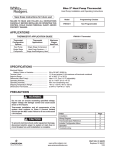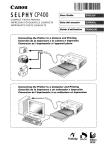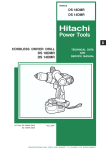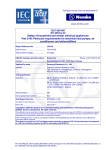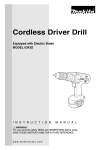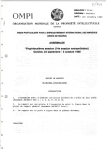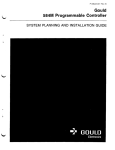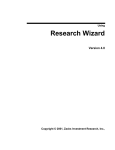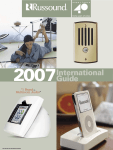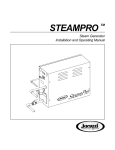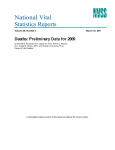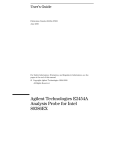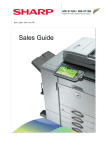Download User's Guide to Model for Aquatic Chemical Speciation Software
Transcript
Scientific Excellence • Resource Protection & Conservation • Benefits for Canadians
Excellence scientifique • Protection et conservation des ressources • Benefices aux Canadians
User's Guide to Model for Aquatic
Chemical Speciation Software
Package: MACS80 (Version
5/1990-VAX and MS-DQS®)
3rd edition
R. Wagemann and G. Regehr
Centrsl illiS Arctic Re~ a
Department · of Fishenes and Oceans
Winnipeg, Manitoba R3T 2N6
1992
Canadian Technical Report of
Fisheries and Aquatic Sciences
1848
~
1+1
Fisheries
and Oceans
Peches
et Oceans
Canadian Technical Report of
Fisheries and Aquatic Sciences
Technical reports contain scientific and technical information that contributes to
existing knowledge but which is not normally appropriate for primary literature.
Technical reports are directed primarily toward a worldwide audience and have an
international distribution. No restriction is placed on subject matter and the series
reflects the broad interests and policies of the Department of Fisheries and Oceans,
namely, fisheries and aquatic sciences.
Technical reports may be cited as full publications. The correct citation appears
above the abstract of each report. Each report is abstracted in Aquatic Sciences and
Fisheries Abstracts and indexed in the Department's annual index to scientific and
technical publications.
Numbers 1-456 in this series were issued as Technical Reports of the Fisheries
Research Board of Canada. Numbers 457-714 were issued as Department of the
Environment, Fisheries and Marine Service, Research and Development Directorate
Technical Reports. Numbers 715-924 were issued as Department of Fisheries and the
Environment, Fisheries and Marine Service Technical Reports. The current series
name was changed with report number 925.
Technical reports are produced regionally but are numbered nationally. Requests
for individual reports will be filled by the issuing establishment listed on the front cover
and title page. Out-of-stock reports will be supplied for a fee by commercial agents.
Rapport technique canadien des
sciences halieutiques et aquatiques
Les rapports techniques contiennent des renseignements scientifiques et techniques qui constituent une contribution aux connaissances actuelles, mais qui ne sont
pas normalement appropries pour la publication dans un journal scientifique. Les
rapports techniques sont destines essentiellement a un public international et ils sont
distribues a cet echelon. 11 n'y a aucune restriction quant au sujet; de fait, la serie reflete
la vaste gamme des interets et des politiques du ministere des Peches et des Oceans,
c'est-A-dire les sciences halieutiques et aquatiques.
Les rapports techniques peuvent etre cites comme des publications completes. Le
titre exact parait au-dessus du résumé de chaque rapport. Les rapports techniques sont
résumés dans la revue Résumés des sciences aquatiques et halieutiques, et ils sont
classes dans l'index annual des publications scientifiques et techniques du Ministere.
Les numeros 1 a 456 de cette serie ont ete publies a titre de rapports techniques de
]'Office des recherches sur les pecheries du Canada. Les numeros 457 a 714 sont parus
titre de rapports techniques de la Direction generale de la recherche et du developpement, Service des peches et de la mer, ministere de l'Environnement. Les numeros 715 a
924 ont ete publies a titre de rapports techniques du Service des peches et de la mer,
ministere des Peches et de l'Environnement. Le nom actuel de la serie a ete etabli lors
de la parution du numero 925.
Les rapports techniques sont produits a ]'echelon regional, mais numerotes
]'echelon national. Les demandes de rapports seront satisfaites par l'etablissement
auteur dont le nom figure sur la couverture et la page du titre. Les rapports epuises
seront fournis contre retribution par des agents commerciaux.
l[o:
ERRATA
Wagemann, R., and G. Regehr. 1992. User's guide to model for aquatic chemical speciation
software package: MACS80 (Version 5/1990-VAX and MS-DOSj. 3rd edition.
Can. Tech. Rep. Fish. Aquat. Sci. 1848: iv + 41 p.
Page 5, Manganese line: columns 2,3 and 4 are misaligned. The "10" after "Manganese" should
be in column 2, and "0.01" "MG/L" should be in columns 3 and 4 respectively.
Page 9, Solid Number 15: the formula should read Mg.(P04) 3H.
Page 17, Quadratic Coefficient Test, quadratic equation formula: the square root should
encompass both terms i.e.
Canadian Technical Report of
Fisheries and Aquatic Sciences 1848
1992
USER'S GillDE TO MODEL FOR AQUATIC
CHEMICAL SPECIATION SOFTWARE PACKAGE:
MACS80 (Version 5/1990-VAX and MS-DOSj
3rd edition
by
R. Wagemann and G. Regehr
Central and Arctic Region
Department of Fisheries and Oceans
Winnipeg, Manitoba R3T 2N6
This is the 44th Technical Report
from the Central and Arctic Region
(c) Minister of Supply and Services Canada 1992
Cat. no. Fs 97-6/1848E
ISSN 0706-6457
Correct citation for this publication is:
Wagemann, R., and G. Regehr. 1992. User's guide to model for aquatic chemical speciation
software package: MACS80 (Version 5/1990-VAX and MS-DOSj. 3rd edition. Can.
Tech. Rep. Fish. Aquat. Sci. 1848: iv + 41 p.
iii
TABLE OF CONTENTS
1.0
LIST OF TABLES
ACKNO~DGMENTSAND
OVERVIEW . . . . . . . . . . . . . . . . 1
1.1 Overview . . . . . . . . . . . . . . . . . 1
1. 2 Narrative . . . . . . . . ~ . . . . . . . . 2
2.0
FILE INFORMATION . . . . . . . . . 3
2.1 Program file . . . . . . . . . . . . . . . 3
2.2 Data input file . . . . . . . . . . . . . . 6
2.2.1
Input procedure and
specifications . . . . . . . . . . 6
2.2.2 Model parameters
and options . . . . . . . . . . . 6
2.2.3
Specifying input values .. .
11
3.0
REPORTING . . . . . . . . . . . . . .
11
4.0
ERROR PROCESSING AND
MESSAGES . . . . . . . . . . . . . . .
12
5.0
TEMPERATURE DEPENDENCE
OF K's . . . . . . . . . . . . . . . . . .
12
6.0
TEMPERATURE DEPENDENCE
OF 'Y'S. • • • • • . • • • • • . . • • • . .
13
1.0
IONIC STRENGTH FROM
CONDUCTIVITY . . . . . . . . . . .
13
8.0
PROGRAM INFORMATION . . . .
13
8.1 Narrative on function
of routines . . . . . . . . . . . . . . . .
14
8.2 Input requirements
of routines . . . . . . . . • . . . . . . .
14
8.3 Processing . . . . . . . . . . . . . . . .
15
8.4 Output of Routines . . . . . . . . . .
16
9.0
EQUATION COEFFICIENT
SIGNIFICANCE TESTS . . • . . . .
17
9.1 Quadratic coefficient test . . . . . . .
17
9.2 Cubic coefficient test . . . . . . . . .
17
10.0
PROGRAM UPDATING . . . . . . .
17
10.1 Adding an anion or metal
to the system . . . . . . . . . . . . .
18
10.2 Adding a solid to the
system . . . . . . . . . . . . . . . . .
19
10.3 Adding an input parameter . . . . . .
19
10.4 Adding chemical species to
output routines . . . . . . . . . . . .
19
10.5 Adding a chemical report
to the system . . . . . . . . . . . . .
19
11.0
REFERENCES . . . . . . . . . . . . . . 20
1
1
2
Data input file MACS80.INPUT
MACS80.INP . . . . . . . . . . .
continued: ANION and METAL
parameter . . . . . . . . . . . . . .
Listing of solids and
their numbers . . . . . . . . . . .
or
. . . . . 4
. . . . . 5
. . . . . 9
LIST OF APPENDICES
~
Appendix
I
Parameters and options: format
of input file . . . . . . . . . . . .
II Listing of anions and metals . .
lli Isometric illustration of SPSUM
array . . . . . . . . . . . . . . . .
IV System flow charts . . . . . . . .
V Sample run of MACS80 . . . . .
. . .
. . .
21
23
. . .
24
. . . . 25
. . .
34
lV
ABSTRACT
Wagemann, R., and G. Regehr. 1992. User's
guide to model for aquatic chemical
speciation software package: MACS80
(Version 5/1990-VAX and MS-DOSj. 3rd
edition. Can. Tech. Rep. Fish. Aquat. Sci.
1848:iv+41 p.
Wagemann, R., and G. Regehr. 1992. User's
guide to model for aquatic chemical
speciation software package: MACS80
(Version 5/1990-VAX and MS-DOSj. 3rd
edition. Can. Tech. Rep. Fish. Aquat. Sci.
1848:iv+41 p.
The manual is a guide to running the
MACS80 chemical speciation program. The
program calculates the equilibrium concentration
of chemical species as a function of pH in fresh
water aquatic systems from the given total
dissolved concentration of metals and anions
either in the presence or absence of one or more
of over sixty solids. It takes into account fifteen
anions and fourteen metals commonly found in
fresh waters including the interaction of metals
(Cu, Cd) with humic dissolved substances and
the adsorption of cadmium on suspended
particulate matter. The program provides the
option of performing these calculations on a
closed or open system with respect to
atmospheric carbon dioxide. A step by step
description of the various input requirements and
output options is given. The program can
calculate results at different temperatures. The
manual provides an overview of the algorithm
including flow-charts and explains the process of
how results are calculated, their precision and
dependence on temperature in terms of
equilibrium constants and activity coefficients.
The manual also provides same guidance to
programmers on how to expand the program to
encompass a larger number of metals and
anions.
Le manuel est un guide d'exploitation du
programme de d~ermination des esp~es
chimiques MACS80. Ce programme permet le
calcul de la concentration~ l'~uilibre d'esp~es
chimiques en fonction du pH dans des syst~mes
d'eau douce~ partir de la concentration totale en
metaux dissous et en anions, en presence ou non
d'une ou plusieurs mati~res solides parmi
soixante. Le programme tient compte de quinze
anions et quatorze metaux communement trouves
en eau douce, ainsi que des interactions de
metaux (Cu, Cd) avec des substances humiques
dissoutes, et de l'adsorption du cadmium sur les
particules en suspension. Le programme offre
la possibilite d'effectuer ces calculs en syst~me
ferme ou en syst~me ouvert, avec le gaz
carbonique atmospherique. U ne description des
differents param~tres d'entree et des options de
presentation des resultats est foumie.
Le
programme peut calculer les resultats ~
differentes temperatures. Le manuel donne un
aper~u de I' algorithme, notamment avec des
graphiques de cheminement, et il explique de
quelle fa~on les resultats sont calcules, indique
leur precision ainsi que leur dependance par
rapport ~ Ia temperature en termes de constantes
d'~uilibre et de coefficients d'activite.
Le
manuel fournit en outre quelques elements ~
!'intention des programmateurs sur Ia fa~n
d'elargir le programme de mani~re ~ incorporer
un nombre accru de metaux et d'anions.
Key words: computer programs; algorithms;
chemical speciation; fresh water; cadmium.
Mots cles: programmes d'ordinateur;
algorithmes; determination d' esp~ces
chimiques; eau douce; cadmium.
1
1.0
ACKNOWLEDGMENTS
OVERVIEW
AND
The MACS80 speciation program has
an extensive history of development,
becoming, through necessity, larger and
more complex at each stage. We sincerely
thank Messrs. D. Abrams, W. Elliot, M.
Judd, D. Bayomi and R. Lypka for their
programming contributions at various stages
of development. We particularly thank Mr.
D. Abrams who was the first to undertake
the programming task, and Mr. D. Costin
(Head of the Freshwater Institute Computer
Section at that time) for their cooperation
and generosity with their time. We also
thank Ms. P. V. Cassidy for typing. One of
us (G. Regehr) adapted, modified and
enhanced the program for use on a MICRO
VAX II computer, as well as
microcomputers under MS-Dos•.
1.1 OVERVIEW
This manual is intended only to
facilitate the use of the program, explain its
various options, and provide a brief
description of the algorithm. The source
code for the program has been published
separately (Wagemann et al. 1990). The
data base used by this program will be
published as a separate compilation of
equilibrium constants with their sources and
the corresponding chemical equations.
However, the user can obtain a hard copy of
the equilibrium constants and activity
coefficients used by the program as
explained later (see section 2.2.2 10)). The
equations used in this program and referred
to in this manual can be found in any
physical chemistry text. The equilibrium
constants used by this program have been
obtained, whenever possible, from a
critically assessed compendium of constants
(Smith and Martell 1976).
To verify the validity of the
calculations as such, a published standard
river water data set was used as the input
and the calculated results were compared
with the published results from 14 other
well-known speciation programs using the
same input (Jenne 1979). The results
obtained by this program were comparable
to those obtained by the other programs that
had the temperature variation option as this
programs has. Nevertheless, there are
numerous modelling pitfalls which can be
more or less severe depending on the type of
aquatic system being analysed and the
specific aim of these calculations. The user
must have some knowledge of physical
chemistry to be able to properly assess the
significance or insignificance of the
shortcomings of chemical modelling in
general, in relation to the particular aquatic
system being analysed in particular, and in
relation to the specific goals under
consideration. The ease of use of the
program cannot absolve the user from
excercising enlightened caution in the
interpretation of results based on some
understanding of ion associations, ion
activity, ionic strength, thermodynamic
constants, chemical equilibria, chemical
kinetics, metastable equilibria, and the
limitations that these concepts may impose
to a greater or lesser degree on the results.
Equally important is an understanding of
what constitutes an appropriate definition of
the physico-chemical system in relation to
the goals sought. The situation is not unlike
that engendered by the availability of very
"user-friendly" statistical programs where
results can be obtained easily and quickly
even by novices but the correct assessment
and interpretation of results still requires an
understanding of the subject matter.
The program MACS80 (Model for
2
Aquatic Chemical Speciation - 1980) is
designed to calculate the concentration of
chemical species in equilibrated freshwater
systems. It requires the specification of
parameters, such as the total dissolved
concentration of chemical species in the
aquatic system. The program can generate
different reports by allowing the user to
defme outputs for specific metals and
anions. Since the program requires the use
of only one input file and performs all of the
input, error-checking, calculations and
report generation without auxiliary
programs, it is relatively simple and
straight-forward to use.
The input for the program consists of
a definition of the physical system and a
specification of the total dissolved
concentration of the main species or
elements.
The program is available in versions
compiled under VAX FORTRAN 77 to run
on a MICRO-VAX II and under Microsoft
FORTRAN Version 5 to run on MS-Dos•
computers. Differences between the two
versions are minor, consisting mainly of
different file naming conventions (e.g.
MACS80.INPUT for the VAX and
MACS80.INP for MS-DOSj. The source
code for the MS-Dos• version has been
published (Wagemann et al. 1990). Source
code and executables for both versions are
available from the authors.
The algorithm of the MACS80
program is based on the equilibrium and
mass balance approach, resulting in a set of
polynomial equations. The coefficients of
the terms in these equations are stored in a
three-dimensional array (APPENDIX III).
The coefficients are indexed by the anion,
metal, and the power of the term in the
equation (i.e., linear, quadratic, cubic; see
sections 8.3 and 10.1). This program is
easily expanded by enlarging the array that
contains the terms of the coefficients and by
adding the necessary equilibrium constants.
The basic principle underlying this approach
is that the chemical equations are expressed
for each ion as a polynomial, and the
solutions are provided by the positive roots
of the polynomial. The program can and
does deal with mixed ligand complexes and
can calculate the concentration of such
mixed ligand species.
1.2 NARRATIVE
The program starts computing by
reading in from a separate input file
(MACS80.INPUT or MACS80.INP for the
microcomputer) a set of chemical and
physical parameter values which defines the
aquatic system. All parameters must be
If a total
specified in this input file.
dissolved concentration of an anion or metal
is not specified, it is set to zero by default
and the calculation proceeds on that basis.
No "seed" values or guessed starting values
need be entered to start the calculation. The
program itself generates the appropriate
starting values for all the variables.
If there is an error on input in the
parameter sets, the system is not analyzed
nor are any reports printed. The program
prints out an error message and stops. If
there are no errors in the set of input
parameters, the program proceeds to analyze
the system.
The species concentrations are
calculated (equilibrium conditions are
assumed) by the solution of the polynomial
equations by iteration between the
anion/metal mass-balance equations, and
utilizing the initial inputs of total
concentrations of anions and metals, and the
physical input parameters defining the
aquatic system. The program calculates the
concentration of each species at each pH
3
increment in the specified pH range. For
the actual processing of the analysis see
section 8.3. If the calculations do not
converge after 100 reiterations the analysis
is stopped, no reports are written for this pH
value and an error message is written. If
there are no positive roots (i.e., negative
concentration) or the concentration of a
particular species is approaching zero, then
the concentration is set to 0.
When the computation is completed,
the program prints out the reports requested.
2.0
FILE INFORMATION
2.1 PROGRAM FILE
The directory MACS contains the file
MACSSO.EXE, which is the executable
program file. The source file exists as
MACSSO.FOR. Updating of the source can .
be done through the VAX editor EVE or
any other compatible ASCII editor. The
source must then be recompiled and linked
to generate a new executable program.
The program is executed under
VMS by entering the command RUN
MACS80 or under nos• by entering
MACS80 after entering data into the input
file MACSSO.INPUT (or MACSSO.INP)
(see Table 1) which must be present in the
MACS directory.
4
Table 1.
Data input file "MACSSO.INPUT or MACSSO.INP"
TITLE
LAKE 382 AT EP, July 18, 1991. RUN 20C
TEMPERATURE
20.0
PC02
.000350 CONTROLS T.D. IC=T
IONIC STRENGTH
0.0036
CONDUCTIVITY
24.0
pH RANGE
MIN=4.5
MAX=8.1
INC=0.2
pH SPECIFIC
SEDIMENT CD CONSTANT = 3.18660D-9 *10'.. (1.1593 *PH)
OUTPUT UNITS:
MOLES/L
MG/L
CONCENTRATION
F
F
LOG(CONC)
F
F
%(CONC)
F
T
DEFINITIONS
F
5
Table 1. continued: ANION and METAL parameters.
02liTPliT FILE
>MACS<
ID>R20C<
SOLID
REPORT
FILENAME
A SULFATE
2
3.3
MG/L
00
F
>
<
AEDTA
3
0
MGIL
00
F
>
<
ANTA
4
0
MG/L
00
F
>
<
A INORGANIC CARBON
.5
9.10-.5
MOLES/L
T
>IC <
A CHLORIDE
6
0.3
MGIL
00
F
>
A ORGANIC CARBON
7
7.2066
MGIL
00
T
>OC <
A SELENITE
8
20-4
MGIL
00
F
>
<
A SILICATE
9
0 ..527
MG/L
00
F
>
<
A AMMONIA
10
0.112
MG/L
00
F
>
<
A ORTHO-PHOSPHATE
11
20-3
MG/L
00
T
>OP <
A ACETATE
12
0
MGIL
00
F
>
<
A SULFIDE
13
O.OD-2
MG/L
00
F
>
<
A SEDIMENT
14
2.0
MG/L
00
T
>SED<
A FLUORIDE
1.5
0.0
MG/L
00
F
>
<
0.9.5
MG/L
00
F
>
<
MSODIUM
<
MMAGNESIUM
2
0.66
MGIL
00
F
>
<
MCALCIUM
3
2.11
MG/L
00
F
>
<
M IRON(Ill)
4
0.040
MGIL
00
F
>
<
M MERCURY(I)
.5
0
MGIL
00
F
>
<
M MERCURY(II)
6
10-.5
MGIL
00
F
>
<
MCADMIUM
7
10-4
MGIL
07
T
>CD <
MCOPPER
8
20-3
MGIL
00
F
>CU <
M IRON(II)
9
0
MG/L
00
F
>
<
M MANGANESE(II) 10
0.01
MGIL
00
F
>
<
MZINC
11
1..50-3
MGIL
00
F
>
<
MPOTASSIUM
12
0.44
MG/L
00
F
>
<
MCOBALT
13
0
MGIL
00
F
>
<
MALUMINIUM
14
0.04
MGIL
00
F
>
<
6
2.2 DATA INPUT FILE
The input file (Table 1) is called
MACS80.INPUT (MACS80.INP under
DOS) and can be edited directly using any
ASCTI editor.
2.2.1 Input procedure and specifications
Data input is done through the
separate input file (MACS80.INPUT; or
MACS80.INP) containing system parameters
and options for units and reports. The layout
of the input file (Table 1) is inflexible and
the data must be typed into the designated
fields.
When values are changed, their
positions in the file must remain constant.
Records for metal or anion concentrations
may be re-arranged or deleted, however
removing a species from consideration is
more easily done by setting its concentration
to zero in the specified field or leaving the
particular field empty, in which case a zero
concentration for that ion is assumed by the
program.
2.2.2 Model parameters and options
A variety of model or system
parameters and report generation options
may be specified. A brief description of
these follows; for a description of the
associated record formats, consult
APPENDIX I.
1) TITLE Parameter:
A record containing this parameter marks
the start of the file. The actual parameter
consists of a title to be printed in the
"ENVIRONMENT:" heading of the reports.
2) TEMPERATURE Parameter:
Since the equilibrium constants and activity
coefficients are temperature dependent, the
desired temperature may be specified for
these calculations. If no temperature is
specified, the calculations are automatically
performed for the derfault setting, namely
25° c.
3) pC02 Parameter:
When this parameter is set to true i.e.
"CONTROLS T.D.IC = T", the total
dissolved inorganic carbon in the system is
determined by equilibration with
atmospheric C02 at any pH. Any value
entered under "INORGANIC CARBON"
(Table 1) is then ignored. When this
parameter is reset to "CONTROLS T.D.IC
= F", the given pC02 value is ignored, and
the program uses the specified total
dissolved inorganic carbon concentration
entered under "INORGANIC CARBON".
The pC02 value must be entered in units of
atmospheres; in the example in Table 1,
0.00035 = 3.5Xl04 Atm.
4) IONIC STRENGTH Parameter:
This parameter defines the ionic strength of
the aquatic system (moles/L) and is used to
calculate activity coefficients. If, in addition,
the CONDUCTIVITY parameter is also
specified, the program will use the given
ionic strength and will omit the calculation
of ionic strength from conductivity.
5) CONDUCTIVITY Parameter:
This parameter defines the conductivity of
the system in terms of JLSiemens/cm and is
used to calculate the ionic strength if the
latter is not specified. If the ionic strength
is specified, this parameter is ignored.
6) pH RANGE Parameters:
These specify the pH range over which
species calculations (at each pH increment)
are to be performed. The range is given by
minimum, maximum and pH increment
7
values and may be adjusted automatically by
the program if the size of the range is not
divisible by the increment. Up to 41 pH
increments may be accommodated within
any given range, i.e. [(pHMAX- pHMIN)
I pHINC] + 1 < 41.
Note: If the minimum value is specified,
the maximum value and increment must also
be specified and vice versa.
7) pH SPECIFIC Parameter:
By specifying this parameter and omitting
specifying the pH range, reports can be
obtained for a single pH value only, namely
the specified pH. If a pH range is also
specified, reports will be obtained at each
pH increment over the entire pH range,
followed by the report for the specific pH,
even if the specific pH value is within the
pH range.
8) SEDIMENT CD CONSTANT
A major application of the program
pertained to whole-lake cadmium
experiments where suspended matter was
found to scavange much of the added
cadmium. The partition coefficent for this
particular suspended matter and lake water
was determined. The program takes
therefore full account of the interaction
between suspended matter and cadmium but
does not currently have the same capability
with respect to other ions. Because the
adsorptive capacity of suspended matter for
cadmium can vary from system to system
and the variation is a function of pH,
suspended matter is hitherto treated in the
program individually rather than generally.
Provision has therefore been made for the
user to specify a different partition
coefficient from that presently in the
program together with different constants
"a" and "b" in the exponential function
"a*lOb~H" as shown in the example input
(Table 1). (No other constant can be
similarly specified by the user without
modification of the source code.)
9) OUTPUT UNITS Options:
Reports can be obtained in terms of
concentration, log of concentration, or
percentage of total dissolved concentration,
each for either moles/1 or mg/1 units
depending on which of the six options are
selected by placing a 'T' (for true) in the
required position.
10) DEFINITIONS Option:
Setting this option to true will cause the
program to print a report of the numerical
values of the equilibrium constants, activity
coefficients, -y-coefficients, C values and
solid numbers which identify the type of
solid.
11) ANION and METAL Parameters:
These parameters represent the concentration
(moles/litre or mg/L) of total anions and
metals in the aquatic system which must be
specified (Table 1), and are used to calculate
the concentrations of the various free ions
and complexes. Also, various solids in
equilibrium with solution may be specified
here under the "SOLID" column (as a
number, see Table 2) which then determines
the "free" metal or anion concentrations in
solution in equilibrium with each solid.
When a "SOLID", two digit, number is
entered after the anion of that solid the total
anion concentration in solution is allowed to
vary as a function of pH i.e., the system is
open with respect to that anion and the
corresponding metal concentration is held
constant over the entire pH range. When
the "SOLID" number is entered after the
metal of that solid, that total metal
concentration in solution is allowed to vary
with pH in order to maintain equilibrium
8
between solid and solution and the metal ion
at all pH values and the anion concentration
is held constant.
The species concentrations are
calculated in the presence of as many solids
as are specified, but the same solid cannot
be entered at the same time under both the
cation and the anion positions, since this
would make the system indeterminate.
A "species report" for any particular
metal or anion is obtained by entering a "T"
(for true) on the appropriate line in the
"REPORT" column (Table 1). The species
report may also be output to a separate text
file (as input for a plotting program) by
filling in the filename parameter in the
"FILENAME" column consisting of at most
3 characters. The 4 characters (at most)
entered in the "ID" field make up the rest of
the file name (See section 3 for a description
of reports available).
9
Table 2. Listing of solids and their numbers.
Solid Number
Chemical Formula
1
2
3
4
Cd(OH)2
CuO
Cu(OH)2
Cu4S04(0H)6
MgCa(C03)2
CaCO]
CdC03
CuC03
Cu2C03(0H)2
Cu3(C03)2(0H)2
Cu2Cl2(0H)3
Mgs(P04)30H
MgH(P04)
Mg3(P04)2(8H20)
5
6
7
8
9
10
11
12
13
14
15
16
17
18
19
20
21
22
23
24
25
26
27
28
29
30
31
32
33
34
35
36
37
38
Mineral Name
Tenorite
Brochantite
Dolomite
Calcite
Malachite
Azurite
Atacamite
M~(P03 )3H
Ca5(P04)30H
CaHP04
Ca3(P04)2
C~(P04)3H
Cd3(P04)2
Cu3(P04)2
CdS
CuS
FeS
Fe(OH) 2
F~(P04) 2 (8H2 0)
FeC03
HgO
HgS (red)
HgS (black)
HgSe03
CuSe03(2H20)
MgSe03
Mg2(HSi04)3
Mn(OH)2
MnC03
MnS (pink)
MnS (green)
Covellite
Mackinawite
Vivianite
Siderite
Montroydite
Cinnabar
Metacinnabar
Chalcomenite
10
Table 2. (Cont'd)
Solid Number
39
40
41
42
43
44
45
46
47
48
49
50
51
52
53
54
55
56
57
58
59
60
61
62
63
Chemical Formula
Mineral Name
MnSe03
Zn(OH)2
ZnO
ZnC03
Zn3(P04)2(4H20)
ZnS
CaSi04
.Hg2C03
Fe(P04)(2H20)
Hg2HP04
Hg2S04
Hg2Cl2
FeOOH
Fe(OH)3
F~03
CoC03
Co(OH)2
Co3(P04)2
CoS
Al(OH)3
Al(OH) 3
AIP04
AlH2P04(0H)2
MgF2
CaF2
Gibbsite
Amorphous
11
2.2.3 Specifyine input values
The input file contains all data
required to specify the system to be
analysed. Data is read from the file by
position, so the user, in editting the data,
should not re-arrange the :file. Certain
features are present in the file to aid in this.
In the first half of the file, most data values
begin in column 25. In the latter portion of
the file, headings and titles are provided in
order to remind the user where data must
reside. In a few cases, the ' > ' and ' < '
symbols are used to mark the locations of
fields. In order to avoid moving data fields,
it is recommended that the input file be
editted in overstrike mode. It is also
recommended that a backup copy of the
original file be kept in case the working
copy is damaged beyond repair.
The only instance where records may
be deleted or rearranged is in the
specification of anions and metals (Table 1).
These records are recognized by the
program by the combination of an 'A' or
'M' in column one, together with the code
number in columns 25-26. (Note that the
species name is not read by the program,
but appears for the user's information only).
3.0
REPORTING
The following reports may be
produced by specifying the report options
discussed earlier. All reports are written
out to text files which may be viewed
through an editor or copied to a printer.
The first three types of reports (if requested)
are combined into one file, the name of
which is created by combining the entries in
the "FILENAME" and "ID" fields specified
in the input fJ.le (Table 1). The main output
file is formatted to a width of 132 columns
and contains control codes for form feed.
This must be taken into account when the
file is printed or viewed.
1) Model Parameters and Options Report:
This report is always generated by the
program and it lists the various parameters
and options that are used to define the
current aquatic system.
2) Equilibrium Constants/ Activity
Coefficients Report:
This report lists the numerical values of the
equilibrium constants "K", "ALPHA" values
(i.e., the ratio of activity coefficients as they
appear in the chemical equilibrium
equation), "GAMMA" values (i.e., the
activity coefficients) and C values (see
section 5.0) used by the program to compute
the concentrations involved in the chemical
equilibria. This report also includes the
solids table which lists the code number
recognized by the program for all solids,
and the names and formulas of the solids.
This report is generated when the
"DEFINITIONS" value is set to true (Table
1).
3) Species Report :
A species report lists the concentrations at
each pH increment of all the calculated
species in solution of the particular metal or
anion specified in the data input file. The
last column in the report lists the calculated
total dissolved value for the anion or metal
at each pH increment. If the analysis has
gone properly, this number should be the
same at each pH increment and be nearly
identical to the inputted total dissolved
concentration, ex-cept when the system is
open with respect to an anion or metal
because of the presence of a solid, or when
the system is open with respect to
atmospheric C02 , in which case dissolved
inorganic carbon will not remain constant as
12
a function of pH.
When reports are
requested in percentage units, the species
concentrations are always reported as a
percentage of the calculated total dissolved
concentration at each pH increment. One
report will be generated for each of the units
specified. Note that each report may consist
of up to three 'pages' in the file.
4) ASCII File Report
The program can output copies of the
species reports to data files which can then
be read by external plotting routines. The
program reads the "FILENAME" field of
each anion or metal. If this field and the
"FILE ID" field are non-blank, a separate
file will be generated for each selected unit.
The file name is created by combining the
entries from these two fields and adding the
extension' .DA' followed by a code number
of 1 to 6 to specify the units reported (1-M,
2-logM, 3-%M, 4-mg/L, 5-log(mg/L), 6%(mg/L)). The file names are created
automatically including the extension, from
the entries in the respective fields. Note that
all plotting files may be suppressed by
setting the 'FILE ID' field to blank even if
some 'FILENAME' fields are filled.
The plotting file will not be 'paged'
as the main data file is, but may be up to
400 characters wide. The file will contain
one record listing the column headings for
the report (intended to help identify the
contents of the file) followed by the data
records as listed in the main output file.
4.0
ERROR PROCESSING
MESSAGES
messages to indicate where and why records
are invalid. When an error is detected, an
error report is produced listing the invalid
records along with the appropriate error
messages. Processing of the data set is then
aborted.
Although the frequency of calculation
errors is much less than that for input
errors, a number of checks are nevertheless
made. Such checks include ensuring that the
roots of quadratic and cubic equations fall
within an allowable range (e.g., if a root
"x" should lie between "a" and "b") and that
the maximum number of iterations is not
exceeded in the iterative calculations.
Reiteration stops when the last calculated
species concentration value differs from the
previous iteration only by a ratio of 1 X 104
or less, for all calculated species. Included
with each error message is a listing of the
values of variables which were involved
with the error, as well as an indication of
where in the program the error occurred.
When an error occurs during the calculation
of a system at a particular pH value, the
program, after signalling the error, aborts
further calculations at that pH increment and
attempts to continue with the next pH
increment in the range.
Calculations are performed in double
precision to 16 decimal digits. The smallest
and largest numbers calculated are 0.5 X
lQ-78 and 0. 7 X 10+76 respectively.
5.0
TEMPERATURE DEPENDENCE
OF K's
AND
To keep error processing under
complete program control, the program
checks for two types of errors: input errors
and calculation errors. As records are input
the program checks for errors, and issues
The familiar van't Hoff equation is
used in the program to calculate the
equilibrium constants (K) at various
temperatures:
K
= e<c + mt(273.ts + t>}
13
C = 1.688X1o-3•
m
t
= - 0.5032•
AH: +2.302log 10(K25)
AHr11
7.0
= temperature in degrees Celsius
AH: = calories/mole, the standard
enthalpy change for the reaction.
The expression is valid for the
approximate temperature range from 0 to
30°C, and is based on the assumption that
the standard enthalpy of the reaction is
constant within this temperature range.
Whenever sufficient information is not
available (i.e., m = 0) to calculate K(t), the
equilibrium constant for 25°C is used
regardless of the temperature specified.
Equilibrium constants which are presently
calculable as a function of temperature are
marked by an asterisk in the
"DEFINITIONS" table (i.e., table of
K-values).
6.0
TEMPERATURE DEPENDENCE
OF -y's.
Activity coefficients ('Y's) were
calculated from ionic strength (I) with the
Bjernum equation (valid up to approximately
I = 0.1 M):
Zj and~
are the charge and ionic
respectively of ion "i".
A = (0.4875) 100·001783• t
B = (0. 3239) 10o.ooos93J• t
"t" is the temperature ec).
A and B were obtained as a function
of temperature by curve-fitting published A,
B vs temperature-data (Manov et al. 1943).
radius
IONIC STRENGTH
CONDUCTIVITY
FROM
The following expression is used in
the program to calculate the ionic strength
from conductivity:
Ionic strength
= Conductivity •
1.8 • 10-s
Ionic strength is expressed in moles/L and
The
conductivity in mSiemens/cm.
expression is valid in the ionic strength
range of 0 - 0. 2 moles/L, i. e. for fresh
waters. The constant in the above equation
was obtained by curve-fitting of published
data of ionic strength vs conductivity
(Ponnamperuma et al. 1966).
8.0
PROGRAM INFORMATION
The following is the control structure
of the routines.
It shows the routines
controlled by each routine.
MAINLINE
INITCM
INPUT
WPARMS
ALPHAC
INSPEC
NWMTLS
NWANIN
SPCALC
OUTPUT
WDEFNS
Wxxx
WHEAD
WFOOT
Note: Wxxx refers to output routines which
are specific to each species (e.g., WS04 ,
WFEIII ).
14
8.1 NARRATIVE ON FUNCTION OF
ROUTINES
bottom of each page.
INITCM - Initializes C and M values to
calculate K constants.
8.2
INPUT
ROUTINES
INPUT - Inputs, syntax checks and decodes
a set of parameters.
INITCM - None.
INPUT - Data file with input parameters.
WP ARMS - Writes the input parameters
report to output file.
WPARMS
parameters.
ALPHAC -Computes "ALPHA" values for
the current set of parameters.
ALPHAC- GAMMA values.
INSPEC - Initializes the species table and
various other values which are dependent
upon pH.
NWMTLS - Calculates new concentrations
for metals upon each iteration.
NWANIN - Calculates new concentration
for anions upon each iteration.
SPCALC - Calculates concentrations of all
species and total dissolved concentrations in
system when equilibrium is reached.
REQUIREMENTS
All
input
and
OF
default
INSPEC - pH, "pC02 controls TDIC" flag,
pC02 value, and KJ ALPHA ratios.
NWMTLS
Specified
K/ ALPHA ratios.
metal
solids,
NWANIN - Specified anion solids, "pC02
controls TDIC" flag, and K/ALPHA ratios.
SPCALC- pH, K/ALPHA ratios, anion and
metal concentrations and number of pH
points for which the system has been
successfully evaluated.
OUTPUT - Report flags, K, ALPHA,
OUTPUT - Calls all output report routines
that were requested by the input parameters.
SETDAT - Library routine which assigns
current date.
WDEFNS -Writes the constants definition
tables to output file.
GAMMA - species concentrations, anion
and metal conversion tables, calculated total
dissolved anions and metals, and the pH
points successfully evaluated.
SETDAT - None.
WDEFNS - K, ALPHA, GAMMA values.
Wxxx - Writes aqueous xxx species report.
WHEAD - Writes a header at the top of
each new page.
WFOOT - Writes a footer and notes at the
Wx.xx - Number of pH points successfully
evaluated, pH values evaluated, equilibrium
and total dissolved concentrations of species,
and conversion factors as well as calculated
total dissolved xx.x.
15
WHEAD - The date, current page number
and input title.
WFOOT
number.
- The date and current page
8.3 PROCESSING
The algorithm solves (positive root)
reiteratively polynomial equations for each
free anion and metal ion in the system and
then uses these to calculate the various
species. The coefficients of the polynomial
are comprised of the products and ratios of
the equilibrium constants
of all the
species that contain the anion or metal in
question. The variable in the polynomial is
the concentration of the free anion or metal.
The constant part of the equation is the
inputted total dissolved concentration of the
anion or metal. For example, the carbonate
ion concentration would be obtained from
the mass balance equation for total dissolved
inorganic carbon (fDIC):
species. The summation in the quadratic
term extends over all di-carbonate
complexes, and in the linear term over all
mono-carbonate complexes. Thus, the
equilibrium constants, activity coefficients
and either an anion or metal ion of the
mono-, di-, and tri-nuclear species make up
the coefficients of the linear, quadratic and
cubic terms respectively of the polynomial
and these are stored in the SPSUM array
(APPENDIX III). Similar polynomials
represent the mass balance for each metal
and anion. For example, the cupric ion
concentration would be calculated from the
total dissolved copper mass balance
equation:
7DCu-(l+l:IJ[Cu]+2(Eq~[Cu]2 + ...
The coefficient of the quadratic term is:
7DJC-(l+EL)[CO)I+2(EQ~[CO~+ ...
The coefficient of the quadratic term of this
polynomial is:
~
is any metal ion involved in the
fomtation of metal-dicarbonate species, ~ is
the corresponding equilibrium constant, and
ai is comprised of the products and ratios of
the activity coefficients of the ions involved
in such a complex. The coefficient of the
linear term I: Li is similarly defined as I: Q,
except it involves only mono-carbonate
The summation ranges over all di-nuclear
copper complexex. Ai is any anion involved
in such a complex. The coefficient of the
linear term is similarly defined except that
the summation includes only mono-nuclear
complexes of copper.
The processing begins by calculating
the coefficients of the metal equations, as
described above, and solving the metal
equation for the free metal concentrations.
The initial metal ion concentration estimate
is obtained from the metal mass balance
polynomials containing initially only known
anion concentrations defined by the pH i.e.
hydroxide ion, and in the case of a system
open to the atmosphere, carbonate ion.
Once the initial free metal ion concentration
16
estimates have been calculated, the
coefficients of the anion equations are
calculated, and the free anion
concentrations are estimated. These in tum
are used to calculate new, more accurate
free metal ion concentrations. This iteration
process continues between the anion and
metal ion polynomials (see APPENDIX III)
until the free metal concentrations change by
less than 0. 01 %. Each chemical species
concentration is then simply calculated using
the appropriate equilibrium constant, activity
coefficients and the free ion concentrations.
For example, the concentration of the
species CuC03 and Cu(C03) 2 would then be
calculated as shown:
[CuC03] = [Cu]*Ka(l8)*[C03], and
[Cu(C03) 2] = [Cu]*Ka(19)*[C03] 2 ;
where Ka(18) and Ka(l9) are the respective
equilibrium constant for these species (with
the activity coefficients incorporated) and
the quantities in square brackets are the
corresponding free ion concentrations. The
numbers in parentheses following Ka are the
indices for the equilibrium constants as
defined within the program. Species
containing hydrogen or hydroxide ions are
incorporated into the "constant", e.g.
[CuHC03] = [Cu]*k*[C03] where
k = Ka(27)*[H+].
The total dissolved concentrations are
constants in the polynomial and are stored in
the arrays "A" and "MTL". Total anion
concentrations are stored in the array "A"
while total metal concentrations are stored
in "MTL".
The variables (i.e., free anion and
metal concentrations) are stored in the
arrays
"XANIN" and
"XMTL",
respectively.
The various coefficients of the terms
in the polynomial are stored in the arrays
"SPSUM", "HSP", and "HSPQ".
The
constants for calculating the species in which
there is an anion and metal, are stored in
"SPSUM". The first row of "SPSUM" is
reserved for storing the constants for
calculating the species which contain only
metals and hydroxide. The constants for
calculating the species which are determined
by multiplying an anion by a constant only
(where the only cation is hydrogen ion) are
stored in the arrays "HSP" and "HSPQ".
The species comprised of only 1 of the
anion of interest are in "HSP" and those
comprised of 2 of the anion of interest are
in "HSPQ".
8.4 OUTPUT OF ROUTINES
ALPHAC- ALPHA values.
INITCM - Initialized C and m values for
calculation of K values.
INPUT - Parameter report, and/or error
messages.
INSPEC - Species table, initialized iteration
counter and equilibrium flag, bomb flag,
and inorganic carbon concentration if Pco2 is
specified.
NW ANIN - Anion concentration and/or
errors.
NWMTLS - New metal concentrations
and/or errors,
and previous metal
concentrations.
OUTPUT - Requested reports.
SETDAT- Date in character form.
SPCALC - Species concentrations to be
output, calculated total dissolved values, and
the current number of pH points successfully
evaluated.
17
WDEFNS- Definitions report.
arises in:
WFOOT - Footer and notes at bottom of
the current page of output.
WHEAD - Header at top of new page of
output.
WPARMS - Input parameters report.
Wxxx - A species report of all species
containing xxx.
9.0
EQUATION COEFFICIENT
SIGNIFICANCE TESTS
Tests were introduced to the program
to determine the significance of the
coefficients used in solving a polynomial,
since some terms in the calculation of the
roots of the quadratic and cubic could
become insignificant in relation to others.
The tests eliminate insignificant coefficients,
simplify the equation, (i.e., a cubic could
become a quadratic equation and a quadratic
could become a linear equation) and produce
a more accurate solution.
9.1 QUADRATIC COEFFICIENT TEST
An exact solution of the quadratic
equation provides the free ion concentration
in question.
ax
2
+ bx + c = 0
.xHowever,
compared
computer
Similarly,
compared
when b2 becomes insignificant
to 4ac in the equation then the
cannot solve the equation.
when 4ac is insignificant
to b2 , a computational problem
An upper limit of 1010 on the size of
the ratio was put in place; the term "4ac" is
considered negligibly small and discarded if
this ratio is exceeded. 1010 is used because
the calculations are done to 14 significant
digits, and at least 4 significant figures in
the calculations are then assured.
9.2 CUBIC COEFFICIENT TEST
The solution to the cubic equation:
ax3
+ bx2 + ex + d
= 0
is obtained by a method of successive
approximations. Starting with -d/c as an
estimate of the root, the program performs
100 iterations of adding or subtracting a
small correction to the root. The initial
correction is -d/2c and is divided by 2 on
each iteration. The process is stopped when
the root becomes consistent to one part in
10,000 (i.e., 0.01 %).
10.0
PROGRAM UPDATING
The program was designed to be
expandable in terms of adding new anions
and metals, new species of existing anions
and metals, and new solids to the system .
Such upgrading requires a text editor and a
FORTRAN compiler compatible with the
source code. The following sections describe
the places in the program where changes
must be made to accomodate additional
ions.
18
10.1 ADDING AN ANION OR METAL
TO THE SYSTEM
1.
Assign the species an "A"
number if it is an anion and or "M" number
if it is metal. If there is no more room in
the "A" or "MTL" array, increment its size
and assign the variable "NAVALS" or
"NMVALS" the new size. If the "A" array
is incremented then increase the number of
rows of "SPSUM" to this size.
Also
increase the arrays "HSP" and "HSP2" to
If the "MTL" array is
this size.
incremented then increase the number of
columns of "SPSUM" to this size. (Mainline
of program)
2. Place the equation to calculate the
constants of the mass balance equation in the
array "SPSUM" (3-dimensional array, see
The first dimension is
Appendix III).
indexed by the anion, the second dimension
is indexed by the metal, and the third is
indexed by the exponents of the anion and
metal concentrations in the mass balance
equation. If the species contains:
1 of the metal and 1 of the anion, use index
1
1 of the metal and 2 of the anion,
2
1 of the metal and 3 of the anion,
3
2 of the metal and 1 of the anion,
4
2 of the metal and 2 of the anion,
5
2. of the metal and 3 of the anion,
6
3 of the metal and 1 of the anion,
7
3 of the metal and 2 of the anion,
8
3 of the metal and 3 of the anion,
9
use index
use index
use index
use index
use index
use index
use index
use index
As an example, the equation for the
species FeHEDTA, containing one ion of
anion 3 and one ion of metal 4 (the [H] is
determined by pH and is calculated into the
constant), would be entered into SPSUM
(3,4,1).
The equation for the species
(FeHEDTA) 2 , containing two ions of anion
3 and two of metal 4, would be entered into
SPSUM(3,4,5). A pictorial presentation of
the SPSUM array is given in APPENDIX
m.
When two species have the same
index into SPSUM (e.g. CuC03 and
CuHC03), the entry should be the sum of
the equations for the two species.
The species with only an anion and
hydrogen ion are stored in"HSP" if the
anion is a linear term and in "HSPQ" if the
anion is a quadratic term. No species
containing only hydrogen and a cubic term
are included in the program's analysis.
For the purposes of discussion here,
hydroxide ion is considered anion 1 (even
though its concentration is calculated instead
of being entered), so no special arrays are
used for this anion. (INSPEC subroutine)
3. The conversion factor for the ion
(mg/mole) will have to be added to
"CONVTA" (anion) or "CONVTM"
(metal). The sizes of these arrays must be
increased as necessary. (Mainline)
4. The new species can then be
added to the output routines of existing
anions and metals as described in section
10.4.
5. The new species report for the
new anions and metals can also be added to
the system as described in section 10.5. ·
6. If there are any new solids, they
can be added as described in section 10.2.
7.
The "K", "ALPHA" and
"GAMMA" values must then be added to
the definitions report.
8. Add statements to the INPUT
19
routine to read and to the WPARMS routine
to write the total dissolved concentration of
the ion. Modify the MACSSO.INPUT file
to provide space for the new entry.
10.2
ADDING A SOLID TO THE
SYSTEM
1. Increment the size of the arrays
"KA", "ALPHA", "C", and "M" and insert
the new alpha equation and c and m values
required. (ALPHAC, INITCM subroutines).
2. Set the variable "NKVALS" to
the size of "KA", which should also be
equal to the size of "ALPHA", "C", and
"M". (Mainline)
3. The formula for calculating the
concentration of the anion from the solid
should be placed in the routine "NWANIN".
The formula for calculating the
concentration of the metal from the solid
should be placed in the routine "NWMTL".
10.3 ADDING AN INPUT PARAMETER
1.
Code a read statement in the
INPUT subroutine and update the
accompanying FORMAT statement. Edit
MACSSO.INPUT to provide space for entry
of the parameter.
2. Code a write statement in the
routine "WPARMS" and update the
accompanying format statement.
3. Update the appropriate common
statements depending on where the
parameter is needed.
Initialize the
parameter in the routine "MAIN".
4. Implement the new parameter in
the program.
10.4 ADDING CHEMICAL SPECIES TO
OUTPUT ROUTINES
1. Assign the new total number of
species to NOV ALS and increase the size of
SPSUM, X, GAM, Z and AO to this value.
Assign the new total number of activity
constants to NKV ALS and increase the size
of KA, C, M and ALPHA to this value.
2. Assign values to the new entries
in C, M, Z and AO. Code the equations to
calculate the new ALPHA value in
subroutine ALPHAC and the new SPSUM
value in subroutine INSPEC.
3. The species concentration should
be calculated at each pH in the routine
"SPCALC" and placed in the array "X"
indexed by the species number.
4. The species concentrations stored
in array "X" should be placed in the
appropriate output routines "Wxxx" (i.e. the
metal and anion output routines). The
appropriate format statements should also be
updated to print the chemical formula for
the species.
5. If the species is an organic
carbon species being placed in the organic
carbon output routine, "WOC" then it
should be divided by another conversion
factor. The factor is 3. 36 x 102 if there is
an A and 6.72 x 102 if there is an A2 •
10.5 ADDING A CHEMICAL REPORT
TO THE SYSTEM
1. Create an output routine called
"Wxxx", where xxx is the chemical formula
of the new chemical (e.g., S04 , Cl, NH3,
Cu). Write the routine with the same
structure as the other output routines
"Wxxx".
2. The species that will be printed
out will be the new species added in section
10.4.
3. Place a call to this new routine in
the "OUTPUT" routine, in the case
structure for anions or the case structure for
20
metals, depending on whether the new
species is an anion or metal.
11.0
REFERENCES
MANOV, G.G., R.G. BATES, W.J.
HAMER, and S.F. ACREE. 1943.
Values of the constants in the DebyeHiickel equation for activity
coefficients. J. Am. Chern. Soc. 65:
1765-1767.
PONN AMPER UMA, F. N.,
E.M.TIANCO nd T.A. LOY. 1966.
Ionic strength of solutions of flooded
soils and other natural aqueous
solutions from specific conductance.
Soil Sci. 102: 408-413.
SMITH, R.M., and A.E. MARTELL.
1976. ritical stability constants.
Volume 4: Inorganic complexes.
Plenum Press, New York, NY. xiii
+ 257 p.
WAGEMANN, R., G. REGEHR, and
R. LYPKA. 1990. Compiler listing
for chemical speciation program
MACS80. VERS.4.1 for Microsoft
Fortran Version 5 for MS-Dos·.
Can. Data Rep. Fish. Aquat. Sci.
818:x+ 190 p.
21
APPENDIX I
Parameters and Options: Format of Input File
All records have one field in common, the command field. The command field
starts in column 1, ends in column 24, and contains character data.
~
Field Name
Starting
Position
Len&th
Data Type
1
TITLE
25
48
character
2
Temperature
25
10
numeric
3
Pco2
25
10
numeric
CONTROLS TDIC
53
1
logical
4
Ionic Strength
25
10
numeric
5
Conductivity
25
10
numeric
6
pH Range MAX
25
6
numeric
MIN
36
6
numeric
INC
47
6
numeric
pH Specific
25
6
numeric
Moles/1
25
1
logical
Mg/1
32
1
logical
7
Output Units
9
22
APPENDIX I (continued)
Parameters and Options: Format of Input File (Output Units) Cont'd
Line
Field Name
Starting
Position
10
Log(moles/1)
25
1
logical
Log(mg/1)
32
1
logical
%(moles/l)
25
1
logical
%(mg/l)
32
1
logical
12
Definitions
25
1
logical
13
Output file
18
4
character
Output file ID
33
4
character
Species type
1
1
character
Species number
25
2
numeric
Concentration
30
10
numeric
Units
45
2
character
Solid number
50
2
numeric
Species report
60
1
logical
Data file name
66
4
character
11
14-end
Leneth
Data Type
Note: The titles under "field name" are only a description of the fields.
23
APPENDIX II
Listing of Anions and Metals
Anion
Name
Metal
Name
1
Hydroxide
1
Sodium
2
Sulfate
2
Magnesium
3
EDTA
3
Calcium
4
NTA
4
Iron (III)
5
Inorganic carbon
5
Mercury (I)
6
Chloride
6
Mercury (II)
7
Organic carbon
7
Cadmium
8
Selenite
8
Copper
9
Silicate
9
Iron (II)
10
Ammonia
10
Manganese
11
Ortho-phosphate
11
Zinc
12
Acetate
12
Potassium
13
Sulfide
13
Cobalt
14
Suspended sediment
14
Aluminum
15
Flouride
24
APPENDIX Ill: Illustration of
SPSUM Array
m
ANION
1 2 3
n
METAL
25
APPENDIX IV
System Flowcharts
26
MAINLINE
(
START
INITCt.l
INPUT
y
Input Error
?
N
ALP HAC
SYSTEM
OUTPUT
(~
STOP
"'----...J
(
STOP
)
J
27
INPUT
START
Init Counter,
Flags and
Report Tags
Read System
Parameters
y
N
WPARMS
Read data for
Anion or Metal
RETURN
28
SYSTEM
START
A(7)=A(7)* 2
6.76x10
Assign PH the
inputed minimum
value.
y
N
Assign A(7)
its saved value
INSPEC
set SKIP
y
SPCALC
WFOOT
N
NWMTLS
Increment pH
STOP
NWANIN
29
NWMTLS
Get first metal
Save current
concentration
of metal
Get next metal
Calculate
metal
concentration
Sum contrib.
to metal
equation
ROOTS
30
NWANIN
Get second anion
Save current
concentration
of anion
Get next anion
Calculate
anion
concentration
Sum contrib.
to anion
equation
ROOTS
31
ROOTS
R=-0/C
RETURN
R=SQRT( -0/B)
RETURN
RETURN"
N
OISC=SQRT(Cz-460)
R= -C+OISC
2B
N
R• -0/C
RETURN
32
ROOTS (cont)
Z=R
N=0
Yl=F(R)
R= -0/C
R=R+Z
Y2=F(R)
Yl=Y2
Z= -z
R= CUBEROOT(-0/A)
Yl=Y2
R=R+Z
Y2=F(R)
Z=Z-/2
N=N+l
R=R-Z
33
OUTPUT
WDEFNS
N
Get first anion
Get first metal
Get first units
Get first units
Get next units
Get next units
Wxxx
Wxxx
N
N
Get next anion
N
Get next metal
y
N
RETURN
34
APPENDIXV
Sample Run of MACS80 Output
11/12/1991
DEPARTMENT OF FISHERIES & OCEANS- WESTERN REGION
CHEMICAL METHODOLOGY- R. WAGEMANN
STANDARD RIVER WATER TEST DATA
TEMPERATURE .....
PC02 ....... .
25.000000 DEG C
.000350 ATM.
IONIC STRENGTH ... .
CONDUCTIVITY ... .
CONTROLS T.D. IC = F
.003600 MOLES/L
.000000 UMHOS/CM
pH RANGE:
MINIMUM .....
5.00
pH SPECIFIC . . . . .
8.01
SEDIMENT CD CONSTANT
MAXIMUM .....
7.50
INCREMENT .....
.20
.5435150D-04•10••( .S064000•PH)
OUTPUT OPTIONS:
UNITS:
MG/L
w
Vl
TABLES:
DEFINITIONS . . . F
OUTPUT FILE: MACSRUNO.DAT
NOTE: 'T.D.' MEANS TOTAL DISSOLVED.
NOTE: ALL MOLES/LAND MG/L VALUES ARE CONCENTRATIONS AS OPPOSED TO ACTIVITIES.
CONCENTRATION WAS 0 OR THE SPECIES CONCENTRATION WAS APPROACHING 0.
NOTE : A CONCENTRATION OF 0 CAN MEAN EITHER THE T.D.
PAGE 1
11/12/1991
DEPARTMENT OF FISHERIES & OCEANS- WESTERN REGION
CHEMICAL METHODOLOGY- R. WAGEMANN
STANDARDRNER WATER TEST DATA
TOTAL DISSOLVED VALUES:
SULFATE . . . . . . . . . . . . . . . . . . . . . .
EDTA . . . . . . . . . . . . . . . . . . . . . . . .
NTA . . . . . . . . . . . . . . . . . . . . . . . . .
INORGANIC CARBON . . . . . . . . . . . . .
CHLORIDE . . . . . . . . . . . . . . . . . . . . .
ORGANIC CARBON . . . . . . . . . . . . . . .
SELENITE . . . . . . . . . . . . . . . . . . . . .
SILICATE . . . . . . . . . . . . . . . . . . . . . .
AMMONIA . . . . . . . . . . . . . . . . . . . . .
ORTHO-PHOSPHATE . . . . . . . . . . . . . .
ACETATE . . . . . . . . . . . . . . . . . . . . .
SULFIDE . . . . . . . . . . . . . . . . . . . . . .
SEDIMENT . . . . . . . . . . . . . . . . . . . . .
FLUORIDE . . . . . . . . . . . . . . . . . . . . .
SODIUM . . . . . . . . . . . . . . . . . . . . . .
MAGNESIUM . . . . . . . . . . . . . . . . . . .
CALCIUM . . . . . . . . . . . . . . . . . . . . .
IRON(Im . . . . . . . . . . . . . . . . . . . . . .
MERCURY(I) . . . . . . . . . . . . . . . . . . .
MERCURY(II) . . . . . . . . . . . . . . . . . . .
CADMIUM . . . . . . . . . . . . . . . . . . . . .
COPPER . . . . . . . . . . . . . . . . . . . . . . .
IRON(II) . . . . . . . . . . . . . . . . . . . . . . .
MANGANESE(II) . . . . . . . . . . . . . . . . .
ZINC . . . . . . . . . . . . . . . . . . . . . . . . .
POTASSIUM . . . . . . . . . . . . . . . . . . . .
COBALT . . . . . . . . . . . . . . . . . . . . . .
ALUMINUM . . . . . . . . . . . . . . . . . . . .
MOLES/L
8.015220-05
O.OOOOOD+OO
0. OOOOOD + 00
1.232200-03
2.79243D-04
2.081430-04
2.53293D-09
3.03354D-04
7.996000-06
6.779880-06
O.OOOOOD+OO
6.23752D-08
2.00000D+OO
O.OOOOOD+OO
5.219660-04
3.084900-04
3.043910-04
1.25342D-07
O.OOOOOD+OO
4.98529D-11
8.89680D-10
7.869060-09
2.685910-07
8.009030-08
7.494650-09
3.58075D-05
O.OOOOOD+OO
7.41235D-07
MG/L
2.57000D+OO
O.OOOOOD+OO
O.OOOOOD+OO
1.48000D+01
9.90000D+OO
2.50000D+OO
2.00000D-04
8.52000D+OO
l.l2000D-01
2.10000D-01
O.OOOOOD+OO
2.000000-03
2.00000D+OO
O.OOOOOD+OO
1.20000D+01
7.50000D+OO
1.22000D+01
7.00000D-03
O.OOOOOD+OO
1.00000D-05
1.00000D-04
5.00000D-04
1.50000D-02
4.40000D-03
4.90000D-04
1.40000D+OO
O.OOOOOD+OO
2.00000D-02
SOLID
NUMBER
00
00
00
00
00
00
00
00
00
00
00
00
00
00
00
00
00
00
00
00
00
00
00
00
00
00
00
00
NOTE: 'T.D.' MEANS TOTAL DISSOLVED.
NOTE: ALL MOLES/LAND MG/L VALUES ARE CONCENTRATIONS AS OPPOSED TO ACTIVITIES.
CONCENTRATION WAS 0 OR THE SPECIES CONCENTRATION WAS APPROACHING 0.
SPECIES
REPORT
F
F
F
T
F
F
F
F
F
F
F
F
F
F
F
F
F
F
F
F
F
T
F
F
F
F
F
F
ASCII
FILENAME
ICRUNO
t..N
0\
CURUNO
NOTE: A CONCENTRATION OF 0 CAN MEAN EITHER THE T.D.
PAGE2
11/12/1991
DEPARTMENT OF FISHERIES & OCEANS- WESTERN REGION
CHEMICAL METHODOLOGY- R. WAGEMANN
STANDARD RIVER WATER TEST DATA
INORGANIC CARBON SYSTEM IN MG/L IN TERMS OF CARBON
SOLID=
pH
C03(-2)
HC03(-)
H2C03(0)
MgC03(0)
MgHC03(+) CaC03(0)
CaHC03(+)
CuC03(0)
5.00 3.91660-06 6.8311D-01 1.4097D+01 5.4933D-07 1.3678D-03 9.9786D-07 1.6019D-03 9.7840D-08
CuHC03(+) Cu(C03)2(-2)
3.8594D-07
1.2128D-13
5.20 9.5840D-06 1.0547D+OO 1.3733D+01 1.3439D-06 2.11140-03 2.4412D-06 2.4727D-03 2.37980-07
5.9230D-07
7.21870-13
5.40 2.3122D-05 1.6055D+00 1.3190D+01 3.2412D-06 3.21290-03 5.8873D-06 3.76260-03 5.67910-07
8.9184D-07
4.15600-12
5.60 5.45910-05 2.3917D+OO 1.2398D+01 7.6492D-06 4.78410-03 1.3893D-05 5.6023D-03 1.3144D-06
1.3024D-06
2.2710D-11
5.80 1.2524D-04 3.4620D+00 1.1323D+01 1.7537D-05 6.9205D-03 3.1849D-05 8.1034D-03 2.9069D-06
1.81730-06
1.1522D-10
6.00 2.76580-04 4.8239D+OO 9.9547D+OO 3.8697D-05 9.6352D-03 7.0269D-05 1.12810-02 6.00740-06
2.36970-06
5.25860-10
~
6.20 5.83070-04 6.4166D+00 8.3548D+OO 8.1499D-05 1.28040-02 1.4797D-04 1.4989D-02 1.12830-05
2.8083D-06
2.08220-09
6.40 1.1672D-03 8.1048D+OO 6.6584D+OO 1.6297D-04 1.6155D-02 2.9586D-04 1.8909D-02 1.8715D-05
2.93900-06
6.91390-09
6.60 2.21810-03 9.7176D+00 5.0372D+OO 3.0935D-04 1.93480-02 5.61530-04 2.26440-02 2.68350-05
2.65900-06
1.88390-08
6.80 4.01980-03 1.1112D+01 3.6343D+OO 5.60020-04 2.21000-02 1.0165D-03 2.58630-02 3.3049D-05
2.0662D-06
4.20480-08
7.00 7.00420-03 1.2216D+01 2.5210D+OO 9.74810-04 2.4272D-02 1.7692D-03 2.8402D-02 3.52530-05
1.3906D-06
7.8149D-08
7.20 1.18410-02 1.3031D+01 1.6967D+00 1.6464D-03 2.5865D-02 2.98770-03 3.0263D-02 3.3138D-05
8.24770-07
1.2419D-07
7.40 1.95820-02 1.3597D+01 1.11710+00 2.7204D-03 2.6965D-02 4.93560-03 3.15440-02 2.8024D-05
4.4008D-07
1.73690-07
8.01 8.40900-02 1.4333D+01 2.8904D-01 1.1639D-02 2.83210-02 2.1078D-02 3.3068D-02 1.0774D-05
NOTE: 'T.D.' MEANS TOTAL DISSOLVED.
NOTE : ALL MOLES/L AND MG/L VALUES ARE CONCENTRATIONS AS OPPOSED TO ACTIVITIES.
CONCENTRATION WAS 0 OR THE SPECIES CONCENTRATION WAS APPROACHING 0.
4.1533D-08
-.l
2.8675D-07
NOTE : A CONCENTRATION OF 0 CAN MEAN EITHER THE T.D.
PAGE3
11112/1991
DEPARTMENT OF FISHERIES & OCEANS- WESTERN REGION
CHEMICAL METHODOLOGY- R. WAGEMANN
STANDARD RIVER WATER TEST DATA
INORGANIC CARBON SYSTEM IN MG/L IN TERMS OF CARBON
SOLID=
pH
MnHC03(+)
AIC03(+)
T.D.IC
5.00 2.6537D-06 6.43990-05 1.4783D+01
5.20 4.0912D-06 7.02800-05 1.4792D+01
5.40 6.2137D-06 6.65290-05 1.4802D+01
5.60 9.2274D-06 5.5884D-05 1.4800D+01
5.80 1.3300D-05 4.20860-05 1.4800D+01
6.00 1.84310-05 2.8478D-05 1.4800D+01
6.20 2.4362D-05 1.73510-05 1.4800D+01
w
00
6.40 3.05670-05 9.5694D-06 1.4800D+01
6.60 3.64190-05 4.82010-06 1.4800D+01
6.80 4.14180-05 2.2427D-06 1.4800D+01
7.00 4.5337D-05 9.74840-07 1.4800D+01
7.20 4.82010-05 3.99210-07 1.4800D+01
7.40 5.01780-05 1.5467D-07 1.4800D+OI
8.01 5.26640-05 6.0309D-09 1.4800D+Ol
NOTE: 'T.D.' MEANS TOTAL DISSOLVED.
NOTE : ALL MOLES/L AND MG/L VALUES ARE CONCENTRATIONS AS OPPOSED TO ACTIVITIES.
CONCENTRATION WAS 0 OR THE SPECIES CONCENTRATION WAS APPROACHING 0.
NOTE: A CONCENTRATION OF 0 CAN MEAN EITHER THE T.D.
PAGE4
11/12/1991
DEPARTMENT OF FISHERIES & OCEANS- WESTERN REGION
CHEMICAL METHODOLOGY- R. WAGEMANN
STANDARD RIVER WATER TEST DATA
COPPER SYSTEM IN MG/L IN TERMS OF COPPER
SOLID=
pH
Cu(+2)
CuOH(+) Cu(OH)2(0) Cu(OH)3(-) Cu(OH)4(-2) Cu2(0H)2(+2) CuS04(0)
CuEDTA(-2) CuHEDTA(-) CuOHEDTA(-3)
S.OO 4.90730-04 8.20SSD-07 7.9649D-08 6.4490D-16 1.24410-23
l.S833D-12 4.92310-06 O.OOOOD+OO O.OOOOD+OO O.OOOOD+OO
S.20 4.8TI8D-04 1.29270-06 1.9887D-07 2.SS19D-1S 7.80240-23
3.92930-12 4.89S2D-06 O.OOOOD+OO O.OOOOD+OO O.OOOOD+OO
S.40 4.82SOD-04 2.026SD-06 4.9412D-07 1.0049D-14 4.8696D-22
9.6S74D-12 4.8432D-06 O.OOOOD+OO O.OOOOD+OO O.OOOOD+OO
S.60 4.7298D-04 3.148SD-06 1.2167D-06 3.9218D-14 3.0119D-21
2.33100-11 4.7484D-06 O.OOOOD+OO O.OOOOD+OO O.OOOOD+OO
S.80 4.SS96D-04 4.81040-06 2.9462D-06 l.SOS1D-13 1.8320D-20
S.441SD-11 4.57810-06 O.OOOOD+OO O.OOOOD+OO O.OOOOD+OO
6.00 4.26680-04 7.134SD-06 6.92S3D-06 S.6072D-13 1.0817D-19
1.19690-10 4.284SD-06 O.OOOOD+OO O.OOOOD+OO O.OOOOD+OO
6.20 3.801SD-04 1.0074D-OS l.S498D-OS 1.9888D-12 6.08070-19
2.386SD-10 3.8176D-06 O.OOOOD+OO O.OOOOD+OO O.OOOOD+OO
6.40 3.14970-04 1.3229D-OS 3.22S6D-OS 6.S602D-12 3.17880-18
4.11S3D-10 3.16340-06 O.OOOOD+OO O.OOOOD+OO O.OOOOD+OO
6.60 2.37660-04 l.S821D-OS 6.1136D-OS 1.9707D-11 l.S134D-17
S.88S7D-10 2.3872D-06 O.OOOOD+OO O.OOOOD+OO O.OOOOD+OO
6.80 l.61SOD-04 l.7039D-OS l.0436D-04 S.3313D-11 6.48910-17
6.82710-10 l.6223D-06 O.OOOOD+OO O.OOOOD+OO O.OOOOD+OO
7.00 9.8869D-OS l.6S32D-OS 1.60470-04 l.2993D-10 2.S06SD-16
6.4267D-10 9.9323D-07 O.OOOOD+OO O.OOOOD+OO O.OOOOD+OO
7.20 S.4977D-OS l.4S69D-OS 2.2414D-04 2.8763D-10 8.7939D-16
4.991SD-10 S.S233D-07 O.OOOOD+OO O.OOOOD+OO O.OOOOD+OO
7.40 2.8112D-OS 1.1807D-OS 2.8789D-04 S.8SS2D-10 2.8373D-1S
3.2784D-10 2.824SD-07 O.OOOOD+OO O.OOOOD+OO O.OOOOD+OO
8.01 2.S170D-06 4.30660-06 4.27770-04 3.S442D-09 6.9964D-14
4.36130-11 2.S296D-08 O.OOOOD+OO O.OOOOD+OO O.OOOOD+OO
w
\0
NOTE: 'T.D.' MEANS TOTAL DISSOLVED.
NOTE : ALL MOLES/LAND MG/L VALUES ARE CONCENTRATIONS AS OPPOSED TO ACTIVITIES.
CONCENTRATION WAS 0 OR THE SPECIES CONCENTRATION WAS APPROACHINGO.
NOTE : A CONCENTRATION OF 0 CAN MEAN EITHER THE T.D.
PAGES
11112/1991
DEPARTMENT OF FISHERIES & OCEANS- WESTERN REGION
CHEMICAL METHODOLOGY- R. WAGEMANN
STANDARDRNER WATER TEST DATA
COPPER SYSTEM IN MG/L IN TERMS OF COPPER
SOLID=
pH
CuNTA(-) Cu{NTA)2(-4) CuOHNTA(-2) CuC03(0) Cu(C03)2(-2) CuHC03(+)
CuC1(+)
CuC12(0)
CuA2
CuNH3(+2)
5.00 O.OOOOD+OO O.OOOOD+OO O.OOOOD+OO 5.1759D-07 3.2080D-13 2.0417D-06 2.6697D-07 3.37740-11 6.1805D-07 2.33450-09
5.20 O.OOOOD+OO O.OOOOD+OO O.OOOOD+OO l.2589D-06 l.9094D-12 3.1334D-06 2.6536D-07 3.35710-11 1.17070-06 3.67750-09
5.40 O.OOOOD+OO O.OOOOD+OO O.OOOOD+OO 3.0044D-06 l.0993D-11 4.7180D-06 2.6249D-07 3.3207D-11 2.14700-06 5.76510-09
5.60 O.OOOOD+OO O.OOOOD+OO O.OOOOD+OO 6.9534D-06 6.0071D-11 6.8897D-06 2.57310-07 3.2552D-11 3.8000D-06 8.95600-09
5.80 O.OOOOD+OO O.OOOOD+OO O.OOOOD+OO l.5378D-05 3.0478D-10 9.6139D-06 2.4805D-07 3.13810-11 6.4538D-06 l.3682D-08
6.00 O.OOOOD+OO O.OOOOD+OO O.OOOOD+OO 3.1780D-05
l.3909D-09 l.2536D-05 2.3212D-07 2.9366D-11 1.04080-05 2.02880-08
~
6.20 O.OOOOD+OO O.OOOOD+OO O.OOOOD+OO 5.9690D-05 5.5077D-09 l.4856D-05 2.0681D-07 2.6163D-11 1.56770-05 2.86380-08
6.40 O.OOOOD+OO O.OOOOD+OO O.OOOOD+OO 9.9006D-05
0
l.8288D-08 l.5548D-05 l.7135D-07 2.1677D-11 2.16020-05 3.75880-08
6.60 O.OOOOD+OO O.OOOOD+OO O.OOOOD+OO l.4196D-04 4.98310-08 l.4066D-05 l.2929D-07 l.6357D-11 2.67370-05 4.49170-08
6.80 O.OOOOD+OO O.OOOOD+OO O.OOOOD+OO l.7484D-04 l.1122D-07 1.09300-05 8.78610-08 l.l115D-11 2.9464D-05 4.83160-08
7.00 O.OOOOD+OO O.OOOOD+OO O.OOOOD+OO l.8649D-04 2.06710-07 7.3563D-06 5.3787D-08 6.8046D-12 2.8979D-05 4.6786D-08
7.20 O.OOOOD+OO O.OOOOD+OO O.OOOOD+OO 1.75310-04 3.2849D-07 4.3632D-06 2.9909D-08 3.7837D-12 2.56910-05 4.11040-08
7.40 O.OOOOD+OO O.OOOOD+OO O.OOOOD+OO l.4825D-04 4.5941D-07 2.32810-06 l.5294D-08 l.9348D-12 2.08160-05 3.31490-08
8.01
O.OOOOD+OO O.OOOOD+OO O.OOOOD+OO 5.6997D-05 7.5848D-07 2.19710-07 l.3693D-09 l.7323D-13 7.38770-06 1.16170-08
NOTE: 'T.D.' MEANS TOTAL DISSOLVED.
NOTE : ALL MOLES/LAND MG/L VALUES ARE CONCENTRATIONS AS OPPOSED TO ACTIVITIES.
CONCENTRATION WAS 0 OR THE SPECIES CONCENTRATION WAS APPROACHING 0.
NOTE : A CONCENTRATION OF 0 CAN MEAN EITHER THE T.D.
PAGE6
11/1211991
DEPARTMENT OF FISHERIES & OCEANS- WESTERN REGION
CHEMICAL METHODOLOGY- R. WAGEMANN
STANDARD RIVER WATER TEST DATA
COPPER SYSTEM IN MG/L IN TERMS OF COPPER
SOLID=
pH Cu(NH3)2(+2) Cu(NH3)3(+2)
CuAc(+)
CuAc2(0)
SSCu
CuF(+)
T.D.Cu
5.00 2.66600-15
6.8618D-22 O.OOOOD+OO O.OOOOD+OO O.OOOOD+OO O.OOOOD+OO 5.0000D-04
5.20 6.65610-15
2.71510-21 O.OOOOD+OO O.OOOOD+OO O.OOOOD+OO O.OOOOD+OO 5.00000-04
5.40 1.65370-14
1.06900-20 O.OOOOD+OO O.OOOOD+OO O.OOOOD+OO O.OOOOD+OO 5.00000-04
5.60 4.07120-14
4.17090-20 O.OOOOD+OO O.OOOOD+OO O.OOOOD+OO O.OOOOD+OO 5.0000D-04
5.80 9.85590-14
1.60010-19 O.OOOOD+OO O.OOOOD+OO O.OOOOD+OO O.OOOOD+OO 5.00000-04
6.00 2.3158D-13
5.9576D-19 O.OOOOD+OO O.OOOOD+OO O.OOOOD+OO O.OOOOD+OO 5.0000D-04
6.20 5.17940-13
2.11110-18 O.OOOOD+OO O.OOOOD+OO O.OOOOD+OO O.OOOOD+OO 5.00000-04
6.40 1.07690-12
6.95320-18 O.OOOOD+OO O.OOOOD+OO O.OOOOD+OO O.OOOOD+OO 5.00000-04
6.60 2.03790-12
2.08380-17 O.OOOOD+OO O.OOOOD+OO O.OOOOD+OO O.OOOOD+OO 5.00000-04
6.80 3.47000-12
5.61640-17 O.OOOOD+OO O.OOOOD+OO O.OOOOD+OO O.OOOOD+OO 5.00000-04
7.00 5.31490-12
1.36070-16 O.OOOOD+OO O.OOOOD+OO O.OOOOD+OO O.OOOOD+OO 5.00000-04
7.20 7.37760-12
2.98430-16 O.OOOOD+OO O.OOOOD+OO O.OOOOD+OO O.OOOOD+OO 5.0000D-04
7.40 9.38360-12
5.9865D-16 O.OOOOD+OO O.OOOOD+OO O.OOOOD+OO O.OOOOD+OO 5.00000-04
8.01
3.2145D-15 O.OOOOD+OO O.OOOOD+OO O.OOOOD+OO O.OOOOD+OO 5.00000-04
~
1.2872D-11
NOTE: 'T.D.' MEANS TOTAL DISSOLVED.
NOTE : ALL MOLES/LAND MG/L VALUES ARE CONCENTRATIONS AS OPPOSED TO ACTIVITIES.
CONCENTRATION WAS 0 OR THE SPECIES CONCENTRATION WAS APPROACHINGO.
NOTE : A CONCENTRATION OF 0 CAN MEAN EITHER THE T.D.
PAGE 7


















































